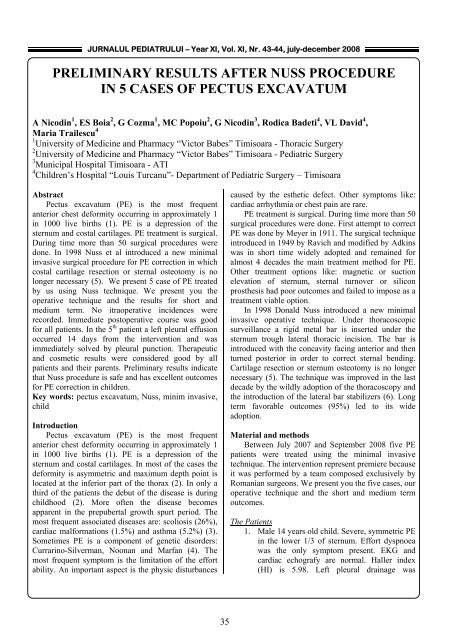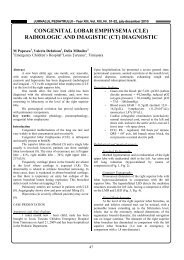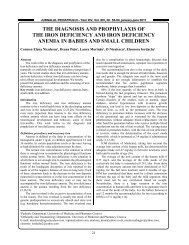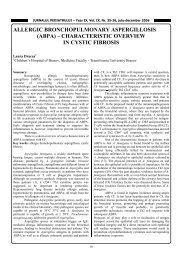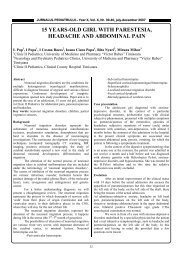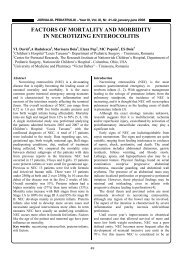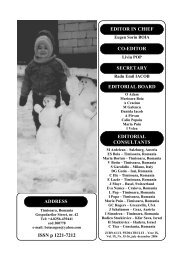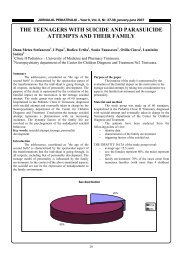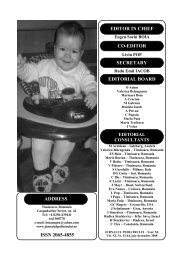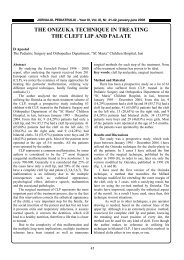preliminary results after nuss procedure in 5 cases of pectus
preliminary results after nuss procedure in 5 cases of pectus
preliminary results after nuss procedure in 5 cases of pectus
You also want an ePaper? Increase the reach of your titles
YUMPU automatically turns print PDFs into web optimized ePapers that Google loves.
JURNALUL PEDIATRULUI – Year XI, Vol. XI, Nr. 43-44, july-december 2008<br />
PRELIMINARY RESULTS AFTER NUSS PROCEDURE<br />
IN 5 CASES OF PECTUS EXCAVATUM<br />
A Nicod<strong>in</strong> 1 , ES Boia 2 , G Cozma 1 , MC Popoiu 2 , G Nicod<strong>in</strong> 3 , Rodica Badeti 4 , VL David 4 ,<br />
Maria Trailescu 4<br />
1 University <strong>of</strong> Medic<strong>in</strong>e and Pharmacy “Victor Babes” Timisoara - Thoracic Surgery<br />
2 University <strong>of</strong> Medic<strong>in</strong>e and Pharmacy “Victor Babes” Timisoara - Pediatric Surgery<br />
3 Municipal Hospital Timisoara - ATI<br />
4 Children’s Hospital “Louis Turcanu”- Department <strong>of</strong> Pediatric Surgery – Timisoara<br />
Abstract<br />
Pectus excavatum (PE) is the most frequent<br />
anterior chest deformity occurr<strong>in</strong>g <strong>in</strong> approximately 1<br />
<strong>in</strong> 1000 live births (1). PE is a depression <strong>of</strong> the<br />
sternum and costal cartilages. PE treatment is surgical.<br />
Dur<strong>in</strong>g time more than 50 surgical <strong>procedure</strong>s were<br />
done. In 1998 Nuss et al <strong>in</strong>troduced a new m<strong>in</strong>imal<br />
<strong>in</strong>vasive surgical <strong>procedure</strong> for PE correction <strong>in</strong> which<br />
costal cartilage resection or sternal osteotomy is no<br />
longer necessary (5). We present 5 case <strong>of</strong> PE treated<br />
by us us<strong>in</strong>g Nuss technique. We present you the<br />
operative technique and the <strong>results</strong> for short and<br />
medium term. No itraoperative <strong>in</strong>cidences were<br />
recorded. Immediate postoperative course was good<br />
for all patients. In the 5 th patient a left pleural effusion<br />
occurred 14 days from the <strong>in</strong>tervention and was<br />
immediately solved by pleural punction. Therapeutic<br />
and cosmetic <strong>results</strong> were considered good by all<br />
patients and their parents. Prelim<strong>in</strong>ary <strong>results</strong> <strong>in</strong>dicate<br />
that Nuss <strong>procedure</strong> is safe and has excellent outcomes<br />
for PE correction <strong>in</strong> children.<br />
Key words: <strong>pectus</strong> excavatum, Nuss, m<strong>in</strong>im <strong>in</strong>vasive,<br />
child<br />
Introduction<br />
Pectus excavatum (PE) is the most frequent<br />
anterior chest deformity occurr<strong>in</strong>g <strong>in</strong> approximately 1<br />
<strong>in</strong> 1000 live births (1). PE is a depression <strong>of</strong> the<br />
sternum and costal cartilages. In most <strong>of</strong> the <strong>cases</strong> the<br />
deformity is asymmetric and maximum depth po<strong>in</strong>t is<br />
located at the <strong>in</strong>ferior part <strong>of</strong> the thorax (2). In only a<br />
third <strong>of</strong> the patients the debut <strong>of</strong> the disease is dur<strong>in</strong>g<br />
childhood (2). More <strong>of</strong>ten the disease becomes<br />
apparent <strong>in</strong> the prepubertal growth spurt period. The<br />
most frequent associated diseases are: scoliosis (26%),<br />
cardiac malformations (1.5%) and asthma (5.2%) (3).<br />
Sometimes PE is a component <strong>of</strong> genetic disorders:<br />
Currar<strong>in</strong>o-Silverman, Noonan and Marfan (4). The<br />
most frequent symptom is the limitation <strong>of</strong> the effort<br />
ability. An important aspect is the physic disturbances<br />
caused by the esthetic defect. Other symptoms like:<br />
cardiac arrhythmia or chest pa<strong>in</strong> are rare.<br />
PE treatment is surgical. Dur<strong>in</strong>g time more than 50<br />
surgical <strong>procedure</strong>s were done. First attempt to correct<br />
PE was done by Meyer <strong>in</strong> 1911. The surgical technique<br />
<strong>in</strong>troduced <strong>in</strong> 1949 by Ravich and modified by Adk<strong>in</strong>s<br />
was <strong>in</strong> short time widely adopted and rema<strong>in</strong>ed for<br />
almost 4 decades the ma<strong>in</strong> treatment method for PE.<br />
Other treatment options like: magnetic or suction<br />
elevation <strong>of</strong> sternum, sternal turnover or silicon<br />
prosthesis had poor outcomes and failed to impose as a<br />
treatment viable option.<br />
In 1998 Donald Nuss <strong>in</strong>troduced a new m<strong>in</strong>imal<br />
<strong>in</strong>vasive operative technique. Under thoracoscopic<br />
surveillance a rigid metal bar is <strong>in</strong>serted under the<br />
sternum trough lateral thoracic <strong>in</strong>cision. The bar is<br />
<strong>in</strong>troduced with the concavity fac<strong>in</strong>g anterior and then<br />
turned posterior <strong>in</strong> order to correct sternal bend<strong>in</strong>g.<br />
Cartilage resection or sternum osteotomy is no longer<br />
necessary (5). The technique was improved <strong>in</strong> the last<br />
decade by the wildly adoption <strong>of</strong> the thoracoscopy and<br />
the <strong>in</strong>troduction <strong>of</strong> the lateral bar stabilizers (6). Long<br />
term favorable outcomes (95%) led to its wide<br />
adoption.<br />
Material and methods<br />
Between July 2007 and September 2008 five PE<br />
patients were treated us<strong>in</strong>g the m<strong>in</strong>imal <strong>in</strong>vasive<br />
technique. The <strong>in</strong>tervention represent premiere because<br />
it was performed by a team composed exclusively by<br />
Romanian surgeons. We present you the five <strong>cases</strong>, our<br />
operative technique and the short and medium term<br />
outcomes.<br />
The Patients<br />
1. Male 14 years old child. Severe, symmetric PE<br />
<strong>in</strong> the lower 1/3 <strong>of</strong> sternum. Effort dyspnoea<br />
was the only symptom present. EKG and<br />
cardiac echografy are normal. Haller <strong>in</strong>dex<br />
(HI) is 5.98. Left pleural dra<strong>in</strong>age was<br />
35
JURNALUL PEDIATRULUI – Year XI, Vol. XI, Nr. 43-44, july-december 2008<br />
necessary for 2 days. He left the hospital 8<br />
days <strong>after</strong> surgery.<br />
2. Male 12 years old child. Symmetric PE.<br />
Associated disease: mitral valve prolapsed,<br />
myopia, isolated atrial extrasystole.<br />
Anamnestic effort dyspnoea was present for a<br />
least one year before. Sternum has a<br />
compressive effect on the right ventricle at the<br />
CT scan. HI is 3.82. After the <strong>in</strong>tervention<br />
bilateral pleural dra<strong>in</strong>age was necessary for 4<br />
days. He left the hospital 6 days from the<br />
<strong>in</strong>tervention.<br />
3. Male 18 years old patient. Symmetric PE. No<br />
symptoms are present. EKG shows a m<strong>in</strong>or<br />
right bundle branch block. HI is 3.62. Right<br />
pleural dra<strong>in</strong>age was ma<strong>in</strong>ta<strong>in</strong>ed for 5 days. He<br />
left the hospital 8 days <strong>after</strong> surgery.<br />
4. Male 14 years old child. Left rotated<br />
asymmetric PE. Associated disease: mitral<br />
valve prolaps, dilated cardiophaty, scoliosis,<br />
pulmonary hypertension. The thoracic<br />
deformity <strong>in</strong>creased significant and the effort<br />
dyspnoea accentuated dur<strong>in</strong>g the past year. CT<br />
scan showed that sternum has a compressive<br />
effect on the right ventricle and the heart is<br />
displaced to the left. HI is 3.7. Bilateral pleural<br />
dra<strong>in</strong>age was ma<strong>in</strong>ta<strong>in</strong>ed for 4 days. He was<br />
released from hospital 6 days from surgery.<br />
5. Male 14 years old child. Cup shape PE slightly<br />
rotated to the left. The deformity <strong>in</strong>creased<br />
significant dur<strong>in</strong>g the past year. Physical exam<br />
showed easy effort fatigue. HI is 4.5. The<br />
bilateral pleural dra<strong>in</strong>age was removed 2 hours<br />
from the <strong>in</strong>tervention. (fig. 1)<br />
1 2 3<br />
Fig. 1 The patients.<br />
4 5<br />
36
JURNALUL PEDIATRULUI – Year XI, Vol. XI, Nr. 43-44, july-december 2008<br />
Pre-operative preparation<br />
Several evaluations were performed for each patient before surgery: spirometry, cardiologic consult, Rx, CT<br />
(fig. 2), EKG, cardiac echography, abdom<strong>in</strong>al echography, genetic consult, ophthalmologic consult. Lab tests<br />
performed are: complete blood count, liver function tests, kidney function tests, <strong>in</strong>flammation tests, glycemia,<br />
blood electrolytes, bleed<strong>in</strong>g and coagulation time.<br />
Fig. 2. CT scan with 3D reconstruction.<br />
Operative technique<br />
- Before surgery the Lorenz bar was shaped to the<br />
desired shape <strong>in</strong> order to reduce the length <strong>of</strong> the<br />
<strong>in</strong>tervention.<br />
- The patient is put under general anesthesia with<br />
oro-tracheal <strong>in</strong>tubation.<br />
- The trocar for thoracoscope is <strong>in</strong>serted <strong>in</strong> 7th<br />
right <strong>in</strong>tercostal space <strong>in</strong> the mid axillary l<strong>in</strong>e.<br />
- Bilateral thoracic <strong>in</strong>cisions are performed <strong>in</strong> the<br />
mid axillary l<strong>in</strong>e at the level <strong>of</strong> deepest po<strong>in</strong>t <strong>of</strong> the<br />
depression.<br />
- In first 4 patients the <strong>in</strong>cision was transverse<br />
while <strong>in</strong> the 5 th case the <strong>in</strong>cision was orientated<br />
vertical.<br />
- Sk<strong>in</strong> tunnels are raised anterior from each<br />
<strong>in</strong>cision to the top <strong>of</strong> the deformity where the thoracic<br />
cavity is entered.<br />
- When the pleural cavity is opened an iatrogenic<br />
pneumothorax is made. This pneumothorax is<br />
sufficient to form the necessary work chamber and is<br />
ma<strong>in</strong>ta<strong>in</strong>ed by us<strong>in</strong>g low ventilation pressures.<br />
- Under thoracoscopic surveillance the <strong>in</strong>troducer<br />
is <strong>in</strong>serted <strong>in</strong> the right pleural cavity.<br />
- Fac<strong>in</strong>g upwards and immediately under the<br />
sternum we slowly passed the <strong>in</strong>troducer through the<br />
anterior mediast<strong>in</strong>um to the left pleural cavity.<br />
- The assistant <strong>in</strong>troduce his f<strong>in</strong>ger <strong>in</strong> the left<br />
pleural cavity and elevates the sternum when the<br />
<strong>in</strong>troducer is passed through the mediast<strong>in</strong>um. This<br />
maneuver <strong>in</strong>crease the distance between sternum and<br />
heart.<br />
- The assistant with his f<strong>in</strong>ger <strong>in</strong>troduced <strong>in</strong> the<br />
pleural cavity expect and guide out the <strong>in</strong>troducer. 37<br />
- The <strong>in</strong>troducer is than elevated and pressure<br />
applied above the sternum <strong>in</strong> order to correct the<br />
deformity.<br />
- We attached an umbilical tape to the left end <strong>of</strong><br />
the <strong>in</strong>troducer and pulled through the tunnel by<br />
withdraw<strong>in</strong>g the <strong>in</strong>troducer from the right side.<br />
- We attached the umbilical tape to the Lorenz bar<br />
and pulled the bar to the left side with the concavity<br />
fac<strong>in</strong>g anterior.<br />
- After is <strong>in</strong>troduced the bar is flipped with<br />
concavity fac<strong>in</strong>g posterior.<br />
- Lateral stabilizer are fitted at each end and<br />
sutured to the rib cage.<br />
- The sk<strong>in</strong> is closed us<strong>in</strong>g non-resorbable sutures.<br />
- We use bilateral pleural dra<strong>in</strong>age <strong>in</strong> 3 <strong>cases</strong> and<br />
unilateral <strong>in</strong> 2 <strong>cases</strong>.<br />
- On the right side we used the thoracoscope<br />
<strong>in</strong>cision for dra<strong>in</strong>age.<br />
- For pa<strong>in</strong> management we <strong>in</strong>serted an epidural<br />
catheter. The patient receives <strong>in</strong>travenous antibiotic, an<br />
anti-<strong>in</strong>flammatory and an analgesic drug for 5 to 6<br />
days.
JURNALUL PEDIATRULUI – Year XI, Vol. XI, Nr. 43-44, july-december 2008<br />
Fig. 3. Trocar <strong>in</strong>troduction.<br />
Fig. 4. Transverse sk<strong>in</strong> <strong>in</strong>cision <strong>in</strong> mid axillary l<strong>in</strong>e.<br />
Fig. 5. Longitud<strong>in</strong>al sk<strong>in</strong> <strong>in</strong>cision <strong>in</strong> mid axillary l<strong>in</strong>e.<br />
Fig. 6 Tunnel<strong>in</strong>g.<br />
Fig. 7. The deformity is corrected by<br />
apply<strong>in</strong>g pressure on sternum and ribs.<br />
Fig. 8. The bar is <strong>in</strong>serted with<br />
the concavity fac<strong>in</strong>g anterior.<br />
38
JURNALUL PEDIATRULUI – Year XI, Vol. XI, Nr. 43-44, july-december 2008<br />
Fig. 9. The bar is flipped with<br />
the concavity fac<strong>in</strong>g posterior.<br />
Fig. 10. Lateral stabilizer are fitted at<br />
each end and sutured to the rib cage.<br />
Fig. 11. The thoracoscope <strong>in</strong>cision<br />
is used for right pleural dra<strong>in</strong>age.<br />
Fig. 12. Bilateral pleural dra<strong>in</strong>age.<br />
Results<br />
No itraoperative <strong>in</strong>cidences were recorded.<br />
Blood loss was m<strong>in</strong>or.<br />
ime <strong>of</strong> operation was between 60 and 90 m<strong>in</strong>utes.<br />
Postoperative course was good for all patients.<br />
No complication occurred <strong>in</strong> 4 <strong>of</strong> the 5 <strong>cases</strong>.<br />
In the 5 th case right pleural effusion developed 14<br />
days from the <strong>in</strong>tervention and was immediately<br />
solved by pleural punction with no further<br />
complication.<br />
We had no bar displacement.<br />
Postoperative pa<strong>in</strong> was m<strong>in</strong>or.<br />
Therapeutic and cosmetic <strong>results</strong> were considered<br />
good by all patients and their parents.<br />
Fig. 13. Postoperative aspect patient 1. Fig. 14. Postoperative aspect patient 2.<br />
39
JURNALUL PEDIATRULUI – Year XI, Vol. XI, Nr. 43-44, july-december 2008<br />
Fig. 15. Postoperative<br />
aspect patient 3.<br />
Fig. 16. Postoperative<br />
aspect patient 4.<br />
Fig. 17. Postoperative<br />
aspect patient 5.<br />
Fig.18. Postoperative Rx patient 1. Fig.19. Postoperative Rx patient 4. Fig.20. Postoperative Rx patient 5.<br />
Discussions<br />
S<strong>in</strong>ce its <strong>in</strong>troduction <strong>in</strong> 1998 Nuss technique for<br />
PE correction had stimulate the <strong>in</strong>terest and was<br />
adopted by a grow<strong>in</strong>g number <strong>of</strong> surgeons all over the<br />
world. Previous studies have established that a HI<br />
greater than 3.1 surgery for PE should be considered<br />
(9). Indication for surgery was established <strong>in</strong> all our<br />
five case based on objective criteria (HI>3.1), cl<strong>in</strong>ical<br />
and psychological criteria. Age <strong>of</strong> the patient was also<br />
a key factor <strong>in</strong> the decision for surgery. The ideal age<br />
for PE correction is just before puberty, when the chest<br />
is still very malleable and the bar is <strong>in</strong> place dur<strong>in</strong>g the<br />
pubertal growth spurt, reduc<strong>in</strong>g so and the possibility<br />
<strong>of</strong> recurrence (6). For adult<br />
PE patient Nuss technique is still a subject <strong>of</strong><br />
debate. Four <strong>of</strong> our patients are <strong>in</strong> pre- and puberty.<br />
One <strong>of</strong> the ma<strong>in</strong> advantages <strong>of</strong> Nuss technique is<br />
the absence <strong>of</strong> the anterior thoracic <strong>in</strong>cision, whom <strong>in</strong><br />
open technique, lead <strong>in</strong> many <strong>cases</strong> to big, unaesthetic<br />
keloids. For this reasons we modified the <strong>in</strong>itial<br />
technique by perform<strong>in</strong>g a longitud<strong>in</strong>al <strong>in</strong>stead <strong>of</strong><br />
transversal <strong>in</strong>cision. In Nuss technique costal cartilage<br />
or sternal osteotomy resection is no longer necessary<br />
and operat<strong>in</strong>g time is significant reduced (7).<br />
The most frequent complication cited before are:<br />
pneumothorax (6.9%), wound <strong>in</strong>fection (4.5%),<br />
pericarditis (2.4%), bar displacement (1.2%) (8). None<br />
<strong>of</strong> these occurred <strong>in</strong> any <strong>of</strong> our patients. Only one<br />
patient developed a pleural effusion 14 days from<br />
surgery resolved successfully by pleural punction.<br />
The <strong>in</strong>itial technique used CO2 pleural <strong>in</strong>sufflation<br />
for creat<strong>in</strong>g the necessary work chamber (5). We<br />
considered that the pneumothorax formed<br />
40
JURNALUL PEDIATRULUI – Year XI, Vol. XI, Nr. 43-44, july-december 2008<br />
spontaneously when the pleural cavity is opened <strong>of</strong>fer<br />
sufficient space and positive pleural pressure is not<br />
necessary.<br />
We consider thoracoscopy necessary <strong>in</strong> order to<br />
avoid heart or lung lesions. Thoracoscopy was<br />
particularly useful for the two <strong>cases</strong> where the sternum<br />
was <strong>in</strong> direct contact with the hart. The assistant<br />
<strong>in</strong>troduce his f<strong>in</strong>ger <strong>in</strong> the left pleural cavity to expect<br />
and guided out the <strong>in</strong>troducer. This adaptation <strong>of</strong> the<br />
<strong>in</strong>itial technique <strong>of</strong>fered a better control for <strong>in</strong>troducer.<br />
An additional adaptation used by us is to elevate the<br />
sternum when the <strong>in</strong>troducer passed through<br />
mediast<strong>in</strong>um <strong>in</strong>creas<strong>in</strong>g the space between the back <strong>of</strong><br />
the sternum and the heart. This maneuver is achieved<br />
by <strong>in</strong>troduc<strong>in</strong>g a f<strong>in</strong>ger <strong>in</strong>side the left pleural cavity<br />
through the site prepared for the left side exit <strong>of</strong> the<br />
<strong>in</strong>troducer. In this way Rockitansky’s subxiphoid<br />
<strong>in</strong>cision becomes unnecessary (10).<br />
One <strong>of</strong> the ma<strong>in</strong> problems for Nuss technique is<br />
greater postoperative pa<strong>in</strong> (7). For our patient pa<strong>in</strong><br />
level was lower than that cited before. Pa<strong>in</strong><br />
management was done ma<strong>in</strong>ly by <strong>in</strong>travenous drugs<br />
and for short time. The epidural catheter was necessary<br />
only <strong>in</strong> 2 <strong>cases</strong> and for 3 days only.<br />
We considered that <strong>in</strong>travenous antibiotics for 6<br />
days are necessary for <strong>in</strong>fection prophylaxis.<br />
Conclusions<br />
- Prelim<strong>in</strong>ary <strong>results</strong> <strong>in</strong>dicate that Nuss operation<br />
for PE correction is a safe surgical technique.<br />
- Postoperative outcomes are good.<br />
- Hospital stay length is short.<br />
- Blood loss is m<strong>in</strong>imal.<br />
- Cosmetic outcomes are excellent, appreciated by<br />
the patients.<br />
- We are wait<strong>in</strong>g for the long times <strong>results</strong>.<br />
References<br />
1. Kelly RE, Lawson ML, Paidas CN et al. Pectus<br />
excavatum <strong>in</strong> a 112-years autopsy series: anatomic<br />
f<strong>in</strong>d<strong>in</strong>gs and the effect on survival. J Pediatr Surg<br />
2005;40:1275-8<br />
2. Kelly RE jr. Pectus excavatum: historical<br />
background, cl<strong>in</strong>ical picture, preoperative<br />
evaluation and criteria for operation. Sem<strong>in</strong> Pediatr<br />
Surg. 2008 Aug;17(3):181-93<br />
3. Popoiu MC, Popoiu A. Anterior chest wall<br />
malformations <strong>in</strong> children. Diagnostic and<br />
treatment. Romania, Timisoara: Eurostampa 2002<br />
4. Radulescu A, Adam O, Boia ES, Popoiu MC.<br />
Pectus excavatum. Diagnostic and treatment.<br />
Romania, Timisoara: Artpress 2005<br />
5. Nuss D, Kelly RE jr, Croitoru DP, et al. A 10 years<br />
review <strong>of</strong> a m<strong>in</strong>imal <strong>in</strong>vasive technique for the<br />
correction <strong>of</strong> <strong>pectus</strong> excavatum. J Pediatr Surg<br />
1998;33:545-552<br />
6. Nuss D. M<strong>in</strong>imally <strong>in</strong>vasive surgical repair <strong>of</strong><br />
<strong>pectus</strong> excavatum. Sem<strong>in</strong> Pediatr Surg. 2008<br />
Aug;17(3):209-17<br />
7. Fonkalsrud EW, Beanes S, Hebra A et al.<br />
Comparison <strong>of</strong> m<strong>in</strong>imally <strong>in</strong>vasive and modified<br />
Ravitch <strong>pectus</strong> excavatum repair. J Pediatr Surg.<br />
2002 Mar;37(3):413-7<br />
8. Park HJ, Lee SY, Lee CS. Complications<br />
associated with the Nuss <strong>procedure</strong>: analysis <strong>of</strong><br />
risk factors and suggested measures for prevention<br />
<strong>of</strong> complications. J Pediatr Surg. 2004<br />
Mar;39(3):391-5; discussion 391-5<br />
9. Kilda A, Basevicius A, Barauskas V et al.<br />
Radiological assessment <strong>of</strong> children with <strong>pectus</strong><br />
excavatum. Indian J Pediatr. 2007 Feb;74(2):143-7<br />
10. Greeber MG. Chest wall and sternum resection<br />
and reconstruction. In Patterson et al, editor.<br />
Pearson’s Thoracic and Esophageal Surgery. 3d<br />
ed. Philadelphia: Churchill Liv<strong>in</strong>gstone Elsevier;<br />
2008. p. 1306-1328.<br />
Correspondence to:<br />
Eugen Boia,<br />
Gospodarilor Street, No. 42,<br />
Timisoara 300778,<br />
Romania,<br />
E-mail: boiaeugen@yahoo.com<br />
41


